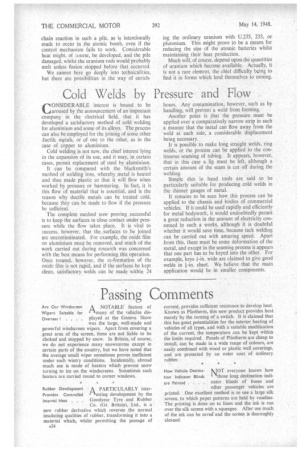Cold Welds by Pressure and Flow
Page 26

If you've noticed an error in this article please click here to report it so we can fix it.
•CONSIDERABLE interest is bound to be aroused by the announcement of an important company in the electrical field, that it has developed a satisfactory method of cold welding for aluminium and some of itsalloys. The process can also be employed for the joining of some other ductile metals, or of one to the other, as in the case of copper to aluminium.
Cold welding is not new, the chief interest lying in the expansion of its use, and it may, in certain cases, permit replacement of steel by aluminium.
It can be compared with the blacksmith's method of welding iron, whereby metal is heated and thus made plastic so that it will flow when worked by pressure or hammering. In fact, it is this flow of material that is essential, and is the reason why ductile metals can be treated cold, because they can be made to flow if the pressure be sufficient.
The complete method now proving successful Is to keep the surfaces in close contact under pressure while the flow takes place. It is vital to Success. however, that the surfaces to be joined are uncontaminated. For example, the oxide film on aluminium must be removed, and much of the work carried out during research was concerned with the best means for performing this operation. Once treated, however, the re-formation of the oxide film is not rapid, and if the surfaces be kept clean, satisfactory welds can be made within 24 hours. Any contamination, however, such as by handling, will prevent a weld from forming.
Another point is that the pressure must be applied over a comparatively narrow strip in such a manner that the metal can flow away from the weld at each side, a considerable displacement being necessary.
It is possible to make long straight welds, ring welds, or the process can be applied to the continuous seaming of tubing. It appears, however, that in this case a ,lip must be left, although a certain amount of the seam is cut off during the welding.
Simple dies in hand tools are said to be particularly suitable for producing cold welds in the thinner gauges of metal.
It remains to be seen how this process can be applied to the chassis and -bodies of commercial vehicles. If it could be used rapidly and efficiently for metal bodywork, it would undoubtedly permit a great reduction in the amount of electricity consumed in such a works, although it is doubtful whether it would save time, because tack welding can be carried out with amazing speed. Apart from this, there must be sonic deformation of the metal, and except in the seaming process it appears that one part has to be keyed into the other. For example, keys wide are claimed to give good welds in h-in. sheet. We believe that the main application would be in smaller components.




















































































